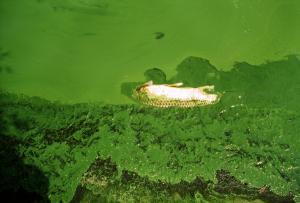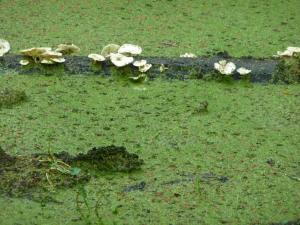Blue-Green Algae Can be Fatal to Pets
- posted: Jun. 30, 2018
 Beware: Toxic Algae May Harm Pets
Beware: Toxic Algae May Harm Pets
If you have a pond in your backyard or hike with your dog in areas where there are standing bodies of water, beware of a potential threat in the water: toxic algae. Found across the United States, these harmful algal blooms occur when certain types of blue-green algae produce toxins which can be deadly to fish, livestock and pets as well as wildlife and people. Often found in lakes, these algae could also potentially invade smaller bodies of water and the cyanobacteria found in some species of algae can be highly toxic to animals and humans.
Penn State has been studying these algal blooms for several years. Most pond algae are harmless, but, it can be difficult to determine the type of algae present or whether or not they are producing toxins by appearance alone.
If you see thick, bright green clumps or mats of floating algae sometimes looking like spilled green paint or pea soup on the surface of a lake or pond, don’t allow pets to drink or swim in the water. Please note, the common small aquatic plant known as duckweed that sometimes covers the surface of lakeshores or ponds is NOT a type of algae and is not harmful.
Algal blooms are most common between July and September in Pennsylvania and are more common in shallow ponds or lakes receiving runoff from farmland. They are perhaps most famously known to occur in PA in Lake Erie, but do affect smaller lakes and ponds in our region. In 2017, York Water Company installed five water circulators in Lake Redman to improve water quality and reduce growth of blue-green algae.
The cyanobacteria within the algae can produce various toxins affecting the liver, nerves or skin. If not treated, they can be fatal. Symptoms include:
- Vomiting, diarrhea, loss of appetite
- Staggering, seizures, paralysis, confusion
- Difficulty breathing, drooling, jaundice of the eyes or gums, decreased urine output
- Skin rash or hives
If you think your dog may have been swimming in or drinking from a pond or lake in which harmful algae are present, monitor for the following signs and seek veterinary help immediately if any of these signs are present.
This blog brought to you by Patton Veterinary Hospital, serving Red Lion, York and the surrounding communities.

<----Duckweed
Location
Patton Veterinary Hospital
425 E Broadway
Red Lion, PA 17356
